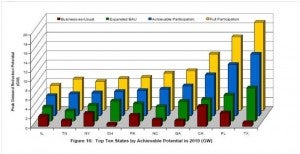This commentary was originally posted on EDF’s Texas Clean Air Matters blog.
Last week was a busy one in Texas, with the beginning of the 83rd Legislative session attention was focused on incoming lawmakers, both seasoned and freshmen, and the opportunity that only happens every two years to address serious issues in Texas including water scarcity, education, tax issues, and of course energy issues.
So it’s understandable that no one seems to have noticed a strongly worded letter to the Electric Reliability Council of Texas (ERCOT) from the North American Electric Reliability Corporation (NERC) last Monday demanding more action to ensure electric reliability in Texas, and asking ERCOT to report back to NERC by April 30 on additional actions taken. NERC isn’t some federal boogey man either; it’s a corporation founded by the electric industry to create commonly accepted standards for electric reliability across North America, usually through voluntary compliance. President Bush’s Energy Policy Act of 2005 gave the corporation “the authority to create and enforce compliance with Reliability Standards,” which is where this letter comes into play.
In their 2012 report, NERC highlighted ERCOT as the only region in North America that was not maintaining adequate electric reserves to meet demand, and with this letter they made it very clear that the actions taken to date have not done enough to mitigate that risk. In the letter, NERC President Gerry Cauley notes that the PUC and ERCOT are continuing to address energy reliability issues, but finds that “solutions have not yet sufficiently materialized to address NERC’s reserve margin concern.”
Cauley goes on to say that “it is still unclear to us how ERCOT intends to mitigate issues that may arise on the current trajectory and when new resources may be available to meet growing demand.” So according to the corporation whose membership consists mostly of utilities, grid operators, large and small customers, and electric regulators, the actions that the PUC and ERCOT have taken at this point are not enough to ensure we’ll have reliable electric supply, risking blackouts as soon as this summer.
As lawmakers settle into Austin for the next few months they’ll certainly be paying close attention to this issue, though many have indicated they would prefer that ERCOT and the PUC develop the solutions to this problem. Cauley’s letter serves as notice that the PUC and ERCOT need to be more aggressive if they want to ensure a reliable supply of power in Texas. Certainly both agencies are putting serious time and effort into keeping the lights on in Texas, including effort so expand existing demand response programs, but NERC clearly thinks they need to be doing more.
All of this reminds me of the Texas drought: a year ago it was a huge looming crises, but a break in the weather took everyone’s mind off of the drying rivers and lakes, even though they never really recovered. Lately the drought has been back in the news as Texans realize that we’re basically in the same place that we were in 2011.
No one could accuse ERCOT or the PUC of sitting idly by or pretending this risk isn’t real. However, they have yet to send a strong enough signal to the market to spur investors in demand response or any other resources to develop new projects. About the only thing that has been done is the extension of the federal production tax credit for wind energy, which has wind developers racing to build new projects in Texas. The concern is that the solutions they’ve begun work on to date may not get us to where we need to be by this summer.
This letter is a reminder that the energy crunch hasn’t gone away, things are not likely to change in the near term if serious action isn’t taken soon. That is a risk we can’t afford to take given a looming drought, a growing economy and a stagnant electric market. NERC has asked ERCOT to report to them on their progress by April 30, near the end of our biennial legislative session, and one in which the critical PUC/ERCOT sunset legislation is expected to pass, maybe legislators should consider a similar request.













